Electric utilities are required to operate and maintain the critical infrastructure that is so vital to the overall health of an electrical network. In many cases, these systems or installations are un-manned, often located in places like distant substations or underground manholes. With these remote sites, engineers, operators and technician crews must be physically on-site to collect data manually, monitor conditions or perform maintenance. This can present utilities with significant issues. Problems may not be discovered until utility personnel is on-site, and in the event of equipment failure, time is of the essence.
HPFF & XLPE Underground Cable Transmission Networks
Underground transmission cable is at the heart of most urban transmission networks. There are approximately 4,500 miles of transmission cable in service that ferry high voltage power into cities across the United States. New York, Washington DC, Chicago, Detroit, Houston, Los Angeles – all the major metropolitan areas in the country and more, are fed by these cable systems.
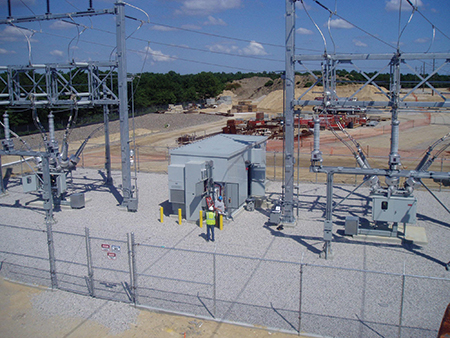
Often, Critical Infrastructure is Located Remotely,
Requiring Personnel to Be On-Site to Monitor Conditions
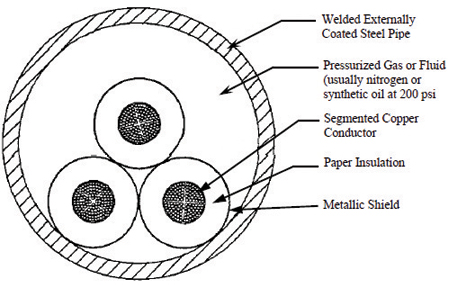
High-Pressure Fluid-Filled Cable (HPFF)
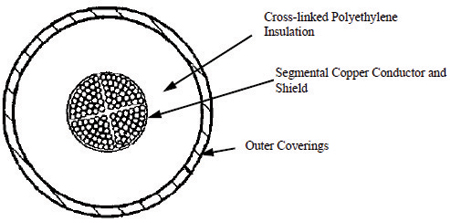
Solid Cross-Linked Polyethylene Cable (XLPE)
There are two dominant types of transmission grade cable: High-Pressure Fluid-Filled (HPFF) and Cross- Linked Polyethylene (XLPE). HPFF AND XLPE cables are completely different in terms of their construction, technology and respective capabilities. What they have in common is a reliance on communications solutions that are pivotal for monitoring cable performance and health.
While XLPE is the newer technology, the majority of our underground network is made up of aging, but critical, High-Pressure Fluid-Filled systems. A typical HPFF underground feeder consists of steel pipe containing three high voltage conductors which are surrounded by dielectric fluid. Pressurization plants are employed to maintain the dielectric fluid pressure at 200 psi to insulate the cable. Additionally, there is a myriad of ancillary gear to transform the cable from underground to aboveground equipment.
Establishing a communication link to provide “real-time” data about your underground cable network greatly benefits the engineers and technicians tasked with overseeing the system’s health. Some key parameters that require monitoring to maintain feeder health include:
- Maintain insulating fluid pressure inside the pipe
- Maintain pothead pressures at ground to air transition points
- Mitigate hot spots in the pipe run
- Monitor pipe cathodic protection
- Sample dielectric fluid for cable deterioration indicting gases
- Monitor fluid levels during dynamic level changes for indication of underground leaks
- Audit multiple critical parameters within the pressurization plant. Fire, access, pump availability, etc.
All of the above topics can be monitored accurately in real time and reported in a manner consistent with a utility’s standard operating procedure.
Catastrophic Unmonitored Conditions
A chain is only as strong as its weakest link. This phrase especially rings true when applied to the transmission, distribution and control of electrical power. With an underground transmission cable network, when one component fails, the whole system can fail, causing catastrophic results. A condition as simple as placing the pump operating switch to “off” during a test or calibration and forgetting to return the switch to an operating condition before exiting the premises can be disastrous – with the feeder pressure degraded, no start or backup would be available to maintain a safe electrification pressure. Cable and potheads could be compromised. If only one pump were chosen for operation, an overload on that pump could result in similar failure modes.
The benefits of monitoring and reporting are many; however, there is one that is most advantageous to electric utilities – the ability to save precious time. Time is a priceless commodity when dealing with feeder complications. Pipe leaks can result in astronomical cleanup costs. The more quickly a leak is detected, the shorter the time and the lower the expense will be for cleanup and re-energization. Leak detection algorithms can mitigate the high volume or long-term spill of dielectric fluid. Hot spots are problematic and destructive. They can be mitigated with slow circulation or oscillation to the benefit of the ca ble. Loss of cathodic protection will cause eventual pipe corrosion it is designed to prevent. High current in the cathodic system often signals a coating failure which should be addressed. Pothead pressure is essential to the cable transition from underground to aboveground. Pump health can be monitored using current transducers and algorithmic settings. Predicting future failures or poor pump performance can prevent downtime and help schedule maintenance visits. Other parameters reported could include fire system health, access and enclosure temperatures. More sophisticated reporting such as nitrogen blanket integrity, pump vibrations, moat liquid levels and oxygen levels in the enclosure is possible.
Establishing a Link
When determining which communications system is best to fit a utility’s needs, there are six variables that need to be considered:
- What manner of instrumentation will be used to collect information?
- Will the information be transmitted as raw data or pre-analyzed by the collection system?
- What communication medium is most readily available while also considering future upgrades?
- Is there a security level to be maintained?
- Will only reporting be performed, or will there be the possibility of some control? This will impact the security levels necessary.
- To whom or where will the collected information be sent or displayed?
Complete or modified systems of information can be delivered to suit the utility’s needs and philosophy. Information can be transmitted from an installation like an HPFF pressurization plant using a plethora of platforms such as telephone lines, T1 lines, fiber, radio and cellular, just to name a few. Security levels can also be implemented to meet all NERC reliability standards and beyond.
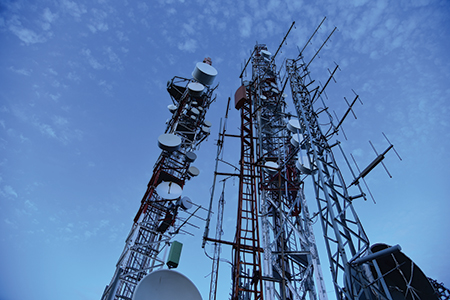
Communications Equipment Can Be Mounted on
Pre-Existing Structures Like Transmission or Cell Towers
Using one communications medium with an eye to upgrading security or even control is more a planning decision than a technical roadblock. Collecting the data at the site also has a number of options. Good science and common sense can produce a collection system which is specific to the location of the installation and the needs of the utility. The result is an increase in security, improved cable performance and confidence in feeder integrity.
Perhaps the last consideration in a solid monitoring system is where the reporting is displayed. Critical infrastructure like pressurization plants should be available or monitored 24/7. Alarms at the reporting site are common, and ease of access to information is paramount. Real-time values increase confidence in the system. When maintenance or operations arrive on site, good feedback instills confidence in any repair or modification made to remove the alarm condition. Utilities all over the country are formulating plans and procedures to extend the life of these HPFF cable systems. Good communication from cable system to operations is a key component to extending system life.
XLPE and Big Comms in the Big Apple
While most large cities are heavily fed by HPFF cable, utilities are also laying new XLPE cable runs to supplement the network. If you were to peel back a New York City street, a super highway of critical infrastructure would be revealed. The essential systems and assets that make New York City go are all intertwined right below your feet. Telecommunications, water supply, public transportation, natural gas and electricity networks all coexist in not-so-perfect harmony. It takes an army of professionals and cutting-edge technology to keep the city that never sleeps up and running.
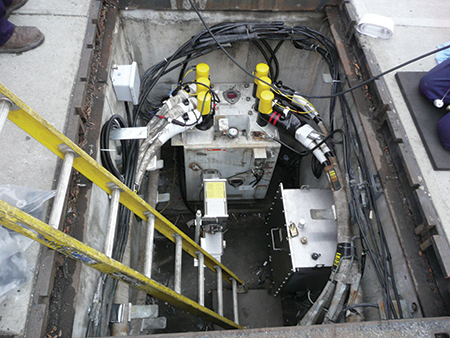
Typical Underground Vault
As utilities install new transmission feeders to keep up with peak demand, they also include ancillary equipment to support the new feeder’s health by monitoring and reporting performance and conditions. Essential underground vaults or manholes are constructed along the feeder path to accommodate XLPE cable splices. However, in addition to cable splices, utilities are now using these spaces for sophisticated communications equipment to monitor and report on both cable and vault conditions. Installed fiber cables are run between the manholes to support system connectivity and strengthen communications capabilities.
Depending on location, these vaults can be supplied with a multitude of different components. Vibration sensors can be employed to report on conditions that might arise from subway activity or overhead street construction. Special cameras can also be used to give the utility a pair of eyes in the vault to detect water levels, track vault access and observe other visual conditions. Temperature sensors are installed to monitor environmental conditions such as extreme temperature changes. Displacement sensors are invaluable to utilities on reporting any movement of the feeder or vault which can signify problems with cable health. Real-time and accurate surveilling of this equipment is paramount because of the isolated nature of the location. Because of the difficulties associated with access, utility-manned maintenance checks might only be scheduled about once every few years. Remote data collecting is imperative to the well being of these unique installations.
Critical Asset Communications and Connectivity
Information is the lifeblood of electric utilities’ critical infrastructure. The ability to collect, analyze and share this information is crucial to operators and engineers maintaining their network. Communication is key and electric utilities are uniquely qualified to find the solutions they need in the digital age. These solutions can be specifically tailored to fit the distinctive needs of the utility and help them securely monitor, control and automate in real time. Levels, alarms, pressures, leaks, environmental conditions and more can all be recorded using an abundance of medium including fiber, radio, copper, cellular and more. Today’s electric utilities are continuously adapting and using the tools available to gain the upper hand in maintaining the health of their critical underground infrastructure. The balance is tipping in their favor.
 Jillian Leinen is the owner and CEO of Walker US, a company that designs and manufactures solutions for electric utilities. She is responsible for running all facets of the business as well as managing high profile projects. Leinen joined Walker after graduating Villanova University, with a BSE in chemical engineering. She quickly put her engineering expertise to use and successfully executed projects that have brought the company into the electric utility industry. She succeeded Bob Ryan as CEO and became the majority shareholder of Walker US in 2016.
Jillian Leinen is the owner and CEO of Walker US, a company that designs and manufactures solutions for electric utilities. She is responsible for running all facets of the business as well as managing high profile projects. Leinen joined Walker after graduating Villanova University, with a BSE in chemical engineering. She quickly put her engineering expertise to use and successfully executed projects that have brought the company into the electric utility industry. She succeeded Bob Ryan as CEO and became the majority shareholder of Walker US in 2016.







